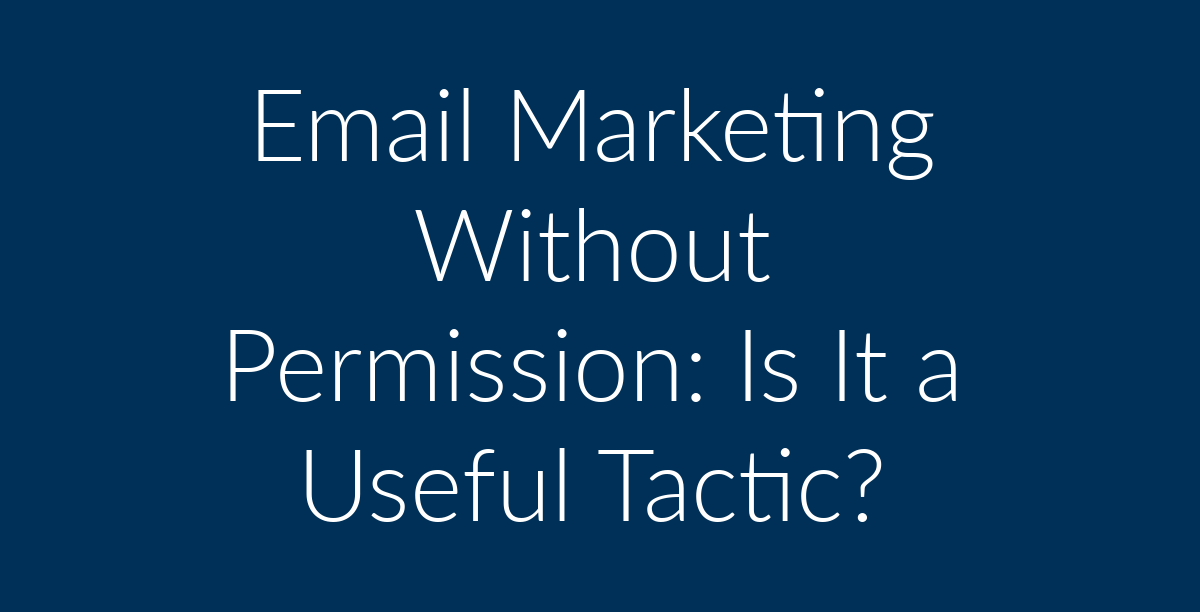You want to reach your audience, but you don’t want to get marked as spam, right? Walking the line between emailing with and without permission can be tricky. Plus, questions of legality regarding the 2003 CAN-SPAM Act also need to be considered.
Here is a look into the tactic of unsolicited emailing marketing, a few of the effects it can have and whether it’s ultimately good for business… or not.
Opt-in Email List vs. Opt-out Email List
First, let’s lay down some terminology. While simple to define, the concept of opt-in email marketing versus opt-out should be noted early on. When a recipient has opted-in, you have received permission from him or her before adding that email address to your list of contacts. Opting-out is when permission has been denied and the person does not want to be contacted again.
For instance, when visitors to your website sign up to receive further newsletters, reminders, etc., they have opted-in. The same can be said when they provide an email address over the phone or on a business card. Best practices include a checkbox or some form of authorization from subscribers to confirm they approve of being contacted.
A double opt-in is when an email is sent to a user that includes a link for them to confirm the subscription. Obtaining the double opt-in is ideal, but it provides a way to opt-out as well. Although letting possible recipients get away may seem counterintuitive, the opt-out option is one of the surest ways to avoid spam complaints. Such complaints can impact your reputation and have negative repercussions on your email marketing strategy. Plus, providing an opt-out option is one of the main requirements of CAN-SPAM.
What Is the CAN-SPAM Act?
CAN-SPAM stands for Controlling the Assault of Non-Solicited Pornography and Marketing Act. Passed in 2003, this law covers the United States’ first national standards surrounding the sending of commercial emails. It established requirements for sending such messages as well as the penalties for breaking them.
While certain guidelines and restrictions are in place, the Act does allow direct marketing email messages to be sent to anyone — even without his or her permission. This holds until the recipient explicitly opts-out. Continuing to send emails after that point contravenes the Act and such violations are enforced by the Federal Trade Commission (FTC).
The monetary penalties for non-compliance can be very costly as each separate email is subject to up to a $43,792 penalty. Additionally, more than one person may be held responsible. For instance, if one company oversees the email marketing campaign for the products of another company, both organizations may be held legally accountable for the email in violation of the law. The Act also lays out criminal penalties for certain aggravated violations such as harvesting email addresses, deceptively transmitting spam messages to fabricate the origin, using open proxies without permission, and more.
What are the CAN-SPAM guidelines? The Act is lengthy as most are, but the essential requirements include:
Clearly disclose the message is an advertisement.
Do not employ deceptive or false information in the header.
Notify recipients of your valid physical postal address.
Include a way to opt-out of receiving future emails with a clear explanation on how to accomplish this.
Comply with opt-out requests promptly and continue to honor them.
Do not utilize misleading subject lines.
Supervise and regulate what is done by others on your behalf.
All in all, these requirements and more are designed to give email users the right to avoid spam in their inboxes and to opt-out of receiving it again. However, marketers may legally send emails to a non-permission list under certain circumstances.
The list must be legally obtained. This can be done by purchasing or renting lists from companies, or through membership to organizations granting permission to email lists.
Emailing like this may appear to be a straightforward and attractive marketing method for some companies, but more factors than legality need to be considered before hitting the send button.
Weighing Efficacy Against Potential Consequences
Sending promotional emails without permission is possible, but doing so can have unintended results. Not only are the people who receive them far less likely to engage with the campaign, but they also are more likely to report them as spam.
Often, users report emails as spam when there isn’t an easy way to unsubscribe. This makes including an easy-to-find unsubscribe link all the more important, as well as clear indications of who the email is from and what it’s about. In fact, studies show close to half, 43%, of users report spam if the sender’s “From” name or address is unrecognized.
When your recipients report your emails as spam, this can lead to increased and more aggressive spam filtering. Through such complaints, as well as the detection of “spammy content” or sloppy code, your email campaigns can be filtered out. On top of following the guidelines above, campaigns should be designed to be clear, clean, and balanced.
Also, spam complaints can lead to blacklisting, making many subscribers unable to receive any further emails from you. When spam alerts are triggered for your domain or sending IP address, you may end up on a spam blacklist. Email service providers use these spam blacklists to check inbound emails before allowing them to be delivered to the recipient. If you are on a blacklist, your emails will be blocked by spam filters and not delivered.
Marketing campaigns can take months to start generating leads and can be spoiled by a handful of spam complaints. With all these risks, is the slight chance of conversion worth it?
Why Companies Shouldn’t Send Without Permission
After combining the legal issues and potential consequences, the main question remains: Is the tactic of sending without permission good for business? The answer ultimately is no. Even if the content you are sending is desirable and highly relevant to the audience, ignoring the importance of permission is detrimental in the long run.
Why? Because the levels of spam complaints and unsubscribe rates it can yield outweigh the rate of success. Additionally, it can tarnish your reputation and make delivering effectively to those who will convert more difficult. Keep in mind, the people receiving your unsolicited emails are unfamiliar with your brand and cold-calling techniques such as these already have slim odds.
The best course of action to improve ROI and to potentially save money in more ways than one is to build a firm foundation of permission with your audience. In addition, maintaining that permission is essential too. Safeguard the integrity of your list by resending opt-in emails periodically to either keep recipients or remove them if they choose to opt-out.
Conclusion
The key takeaway is that while emailing without permission is possible, it is not practical in a business sense. For successful, permission-based email marketing, the best practices include:
Always secure permission before sending.
Double opt-in for further protection.
Set clear expectations on content and mailing frequency.
Deliver engaging and valuable content to your audience on a regular basis.
Maintain permission.
Most importantly, be sure to provide a clear means to opt-out and respect the choice when it’s been made.
Success is never guaranteed. However, by gaining permission, staying within the law, avoiding “spammy” characteristics and sending interesting content to resonate with your customers, you can be one step closer to achieving it.
Resources
http://www.lsoft.com/resources/optinlaws.asp
https://www.ftc.gov/tips-advice/business-center/guidance/can-spam-act-compliance-guide-business
https://keap.com/business-success-blog/marketing/email-marketing/permission-based-email-marketing
https://synchronicitymarketing.com/emailing-without-permission/
https://mailchimp.com/help/the-importance-of-permission/


